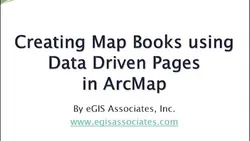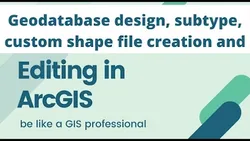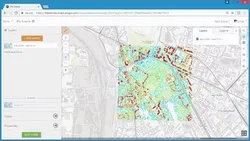
ArcMap & ArcCatalog 
This playlist provides an overview of ArcMap and ArcCatalog, two components of the ArcGIS software suite. It covers topics such as the differences between ArcMap and ArcGIS Pro, creating grid indexes, georeferencing CAD files, and using layer files. It is a great resource for those looking to learn the basics of ArcGIS. ▼
ADVERTISEMENT
Course Feature
![]() Cost:
Cost:
Free
![]() Provider:
Provider:
Youtube
![]() Certificate:
Certificate:
Paid Certification
![]() Language:
Language:
English
![]() Start Date:
Start Date:
On-Demand
Course Overview
❗The content presented here is sourced directly from Youtube platform. For comprehensive course details, including enrollment information, simply click on the 'Go to class' link on our website.
Updated in [February 21st, 2023]
This playlist discusses ArcMap and Geodatabase basics on ArcGis. You will also get to understand the difference between ArcMap and ArcGis Pro, Creating Grid Index in ArcMap, Georeferencing CAD Files in ArcMap and using Layer files in ArcMap and ArcGis Pro.
(Please note that we obtained the following content based on information that users may want to know, such as skills, applicable scenarios, future development, etc., combined with AI tools, and have been manually reviewed)
ArcMap & ArcCatalog is a great course for those who want to learn the basics of ArcGIS. It covers the fundamentals of ArcMap and ArcGIS Pro, including creating grid index, georeferencing CAD files, and using layer files. Learners will gain an understanding of the differences between ArcMap and ArcGIS Pro, and how to use them to create and manage geospatial data. Additionally, they will learn how to use the tools available in ArcMap and ArcGIS Pro to create and edit maps, analyze data, and create visualizations. Finally, they will learn how to share their work with others, and how to use the ArcGIS Online platform to collaborate with others.
[Why to learn]: ArcMap & ArcCatalog is a great course for those who want to learn the basics of ArcGIS. It provides a comprehensive introduction to the fundamentals of ArcGIS, and is a great starting point for those who are new to the platform. It covers the basics of creating and managing geospatial data, as well as how to use the tools available in ArcMap and ArcGIS Pro to create and edit maps, analyze data, and create visualizations. Additionally, learners will gain an understanding of the differences between ArcMap and ArcGIS Pro, and how to use them to collaborate with others.
[Development Paths]: After completing the ArcMap & ArcCatalog course, learners can continue their learning journey by exploring more advanced topics in ArcGIS. This could include topics such as creating custom maps, using geoprocessing tools, and creating 3D models. Additionally, learners can explore the various applications of ArcGIS, such as creating web maps, using the ArcGIS Online platform, and creating mobile applications.
[Related Learning Suggestions]: Learners who are interested in learning more about ArcGIS can explore other courses offered by Esri, such as Introduction to GIS, Introduction to Spatial Analysis, and Introduction to Geoprocessing. Additionally, learners can explore other courses related to GIS, such as Introduction to Remote Sensing, Introduction to Cartography, and Introduction to Geospatial Data Science.
[Applications]
After completing this course, users should be able to apply the knowledge gained to create and manage geospatial data in ArcMap and ArcGis Pro. They should be able to create grid indexes, georeference CAD files, and use layer files in both ArcMap and ArcGis Pro. Additionally, users should be able to identify the differences between ArcMap and ArcGis Pro.
[Career Paths]
1. GIS Analyst: GIS Analysts use geographic information systems (GIS) to analyze and interpret data related to the environment, land use, and other geographic phenomena. They create maps, analyze trends, and develop models to help organizations make informed decisions. GIS Analysts are in high demand as the use of GIS technology continues to grow and develop.
2. GIS Developer: GIS Developers are responsible for designing, developing, and maintaining GIS applications and databases. They use programming languages such as Python and JavaScript to create custom GIS applications and integrate GIS data into existing systems. GIS Developers are in high demand as organizations increasingly rely on GIS technology to make decisions.
3. GIS Technician: GIS Technicians are responsible for collecting, organizing, and analyzing geographic data. They use GIS software such as ArcMap and ArcGIS Pro to create maps, analyze trends, and develop models. GIS Technicians are in high demand as organizations increasingly rely on GIS technology to make decisions.
4. GIS Consultant: GIS Consultants provide advice and guidance to organizations on how to use GIS technology to solve problems. They use their knowledge of GIS software such as ArcMap and ArcGIS Pro to develop solutions and provide recommendations. GIS Consultants are in high demand as organizations increasingly rely on GIS technology to make decisions.
Course Provider

Provider Youtube's Stats at AZClass
Discussion and Reviews
0.0 (Based on 0 reviews)
Explore Similar Online Courses

The poetry of Sorley MacLean

Easy Chocolate Making: All the Basics from Bean to Bar

Python for Informatics: Exploring Information

Social Network Analysis

Introduction to Systematic Review and Meta-Analysis

The Analytics Edge

DCO042 - Python For Informatics

Causal Diagrams: Draw Your Assumptions Before Your Conclusions

Whole genome sequencing of bacterial genomes - tools and applications

Deep Learning

How to create new shape file and geodatabase in ArcGIS


Start your review of ArcMap & ArcCatalog